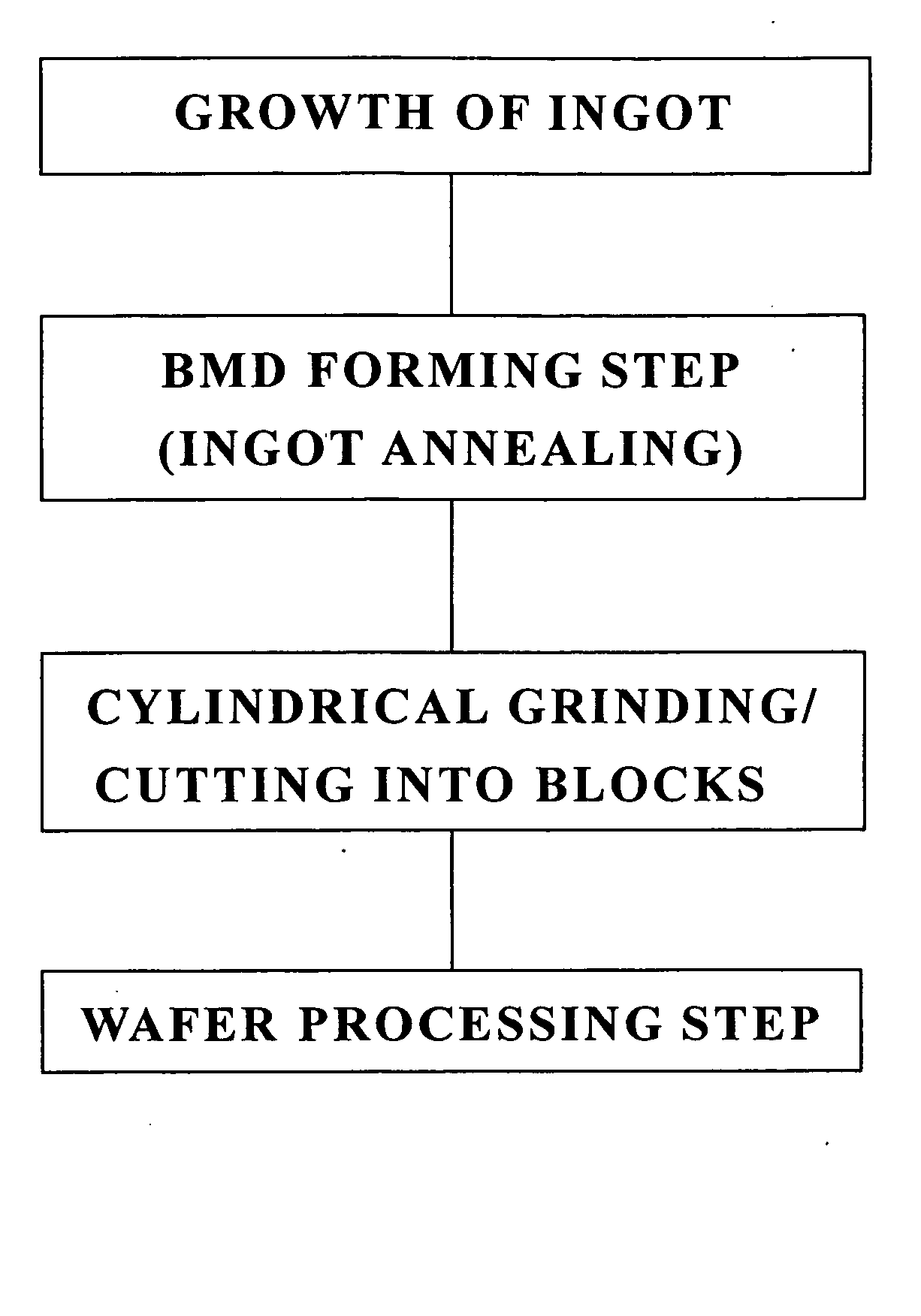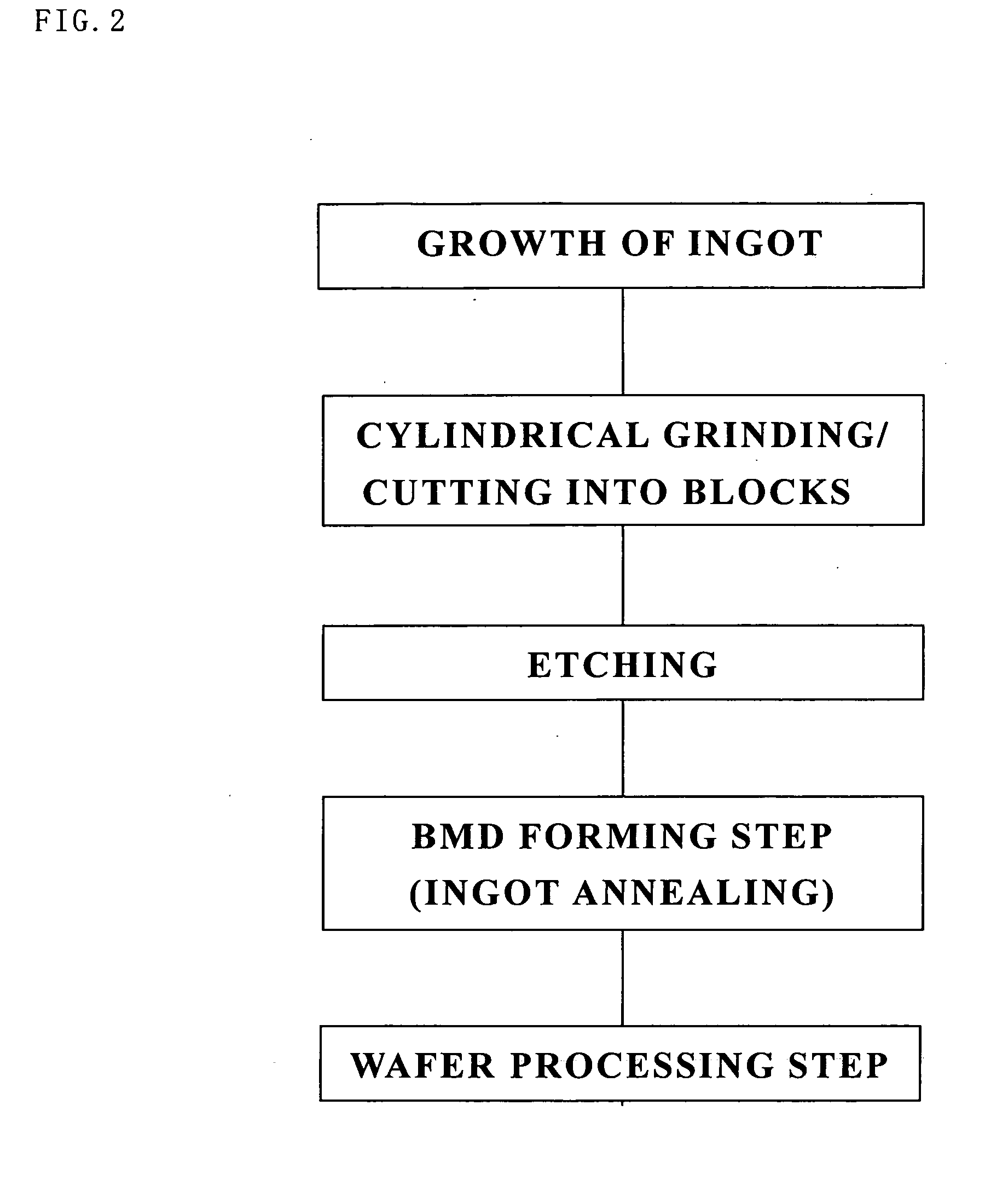Method for producing a wafer
a wafer and processing method technology, applied in the direction of polycrystalline material growth, after-treatment details, etc., can solve the problems of reducing the ig capability of heat treatment for providing ig in the production of wafers, affecting the quality of the wafer, etc., to achieve high ig capability, reduce the effect of heat treatment and reducing the ig capability of producing wafers
- Summary
- Abstract
- Description
- Claims
- Application Information
AI Technical Summary
Benefits of technology
Problems solved by technology
Method used
Image
Examples
example 1
[0142] A silicon single crystal ingot with an oxygen concentration of 13-15×1017 atoms / cm3 [oldASTM] and with a nitrogen concentration of 5-9×1012 atoms / cm3 was grown by CZ method. This ingot was cylindrically ground and cut into a plurality of blocks and thereby an ingot with a diameter of about 300 mm and with a length of about 30 cm was obtained.
[0143] A BMD forming step of subjecting the above ingot to heat treatment in a state of an ingot as it is to form BMDs inside was performed. First, the entire surface of the ingot was etched by about 200 μm by an acidic etchant consisting of HF / HNO3, and thereby metal impurity contaminating a surface thereof was removed.
[0144] After that, the ingot was put in the heat-treating furnace as shown in FIG. 4 in a state of an ingot as it is, and heat treatment was performed.
[0145] The heat treatment was performed that temperature was raised from the room temperature to 500° C. at a temperature rising rate of 10° C. / min, then raised to 1000° ...
example 2
[0149] A silicon single crystal ingot with an oxygen concentration of 13-15×1017 atoms / cm3 [oldASTM] was grown by CZ method. With regard to the silicon single crystal, a crystal in NPC region was grown by controlling a growth rate of the crystal. The ingot was cylindrically ground and cut into a plurality of blocks, and thereby an ingot with a diameter of about 300 mm and with a length of about 30 cm was obtained.
[0150] After that, by performing BMD forming step and wafer processing step in the same manner as Example 1, about 300 silicon wafers with a diameter of 300 mm were obtained. With regard to the wafers obtained as described above, BMD density was evaluated by an infrared tomographic method. The result was a sufficient BMD density of 3×109 numbers / cm3. Thus, wafers with high IG capability were obtained.
example 3
[0153] A silicon single crystal ingot with an oxygen concentration of 13-15×1017 atoms / cm3 [OldASTM] and with a nitrogen concentration of 5-9×1012 atoms / cm3 was grown by CZ method. This ingot was cylindrically ground and cut into a plurality of blocks and thereby an ingot with a diameter of about 300 mm and with a length of about 30 cm was obtained.
[0154] The above ingot was subjected to the first heat-treating step in a state of an ingot as it is. First, the entire surface of the ingot was etched by about 200 μm by an acidic etchant consisting of HF / HNO3, and thereby metal impurity contaminating a surface thereof was removed.
[0155] After that, the ingot in a state of an ingot was put in the heat-treating furnace as shown in FIG. 4 as it is, and heat treatment was performed.
[0156] The heat treatment was performed that temperature was raised from the room temperature to 500° C. at a temperature rising rate of 10° C. / min, then raised to 1000° C. at a temperature rising rate of 1° C...
PUM
| Property | Measurement | Unit |
|---|---|---|
| temperature | aaaaa | aaaaa |
| temperature | aaaaa | aaaaa |
| temperature | aaaaa | aaaaa |
Abstract
Description
Claims
Application Information
 Login to View More
Login to View More - R&D
- Intellectual Property
- Life Sciences
- Materials
- Tech Scout
- Unparalleled Data Quality
- Higher Quality Content
- 60% Fewer Hallucinations
Browse by: Latest US Patents, China's latest patents, Technical Efficacy Thesaurus, Application Domain, Technology Topic, Popular Technical Reports.
© 2025 PatSnap. All rights reserved.Legal|Privacy policy|Modern Slavery Act Transparency Statement|Sitemap|About US| Contact US: help@patsnap.com



